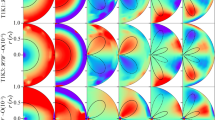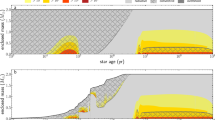Abstract
DESPITE the trend of recent evidence, both observational and theoretical1, that radial pulsations may not be the source of variation in pulsars, the pulsational hypothesis has still not been disproved. In particular, the expected pulsational damping times of degenerate stars may be sufficiently long (for small oscillations) that observable variations could occur over a period of millions of years (J. M. Cohen and L. C. Rosen, private communication), in spite of some earlier theoretical evidence to the contrary2. One of the chief difficulties with the pulsational hypothesis, however, is that the calculated fundamental periods are longer than 1.5 s for white dwarfs3,4 and shorter than 1 ms for most neutron-star models5, whereas most pulsars have periods lying between these extremes. Overtone pulsations in white dwarfs have been suggested as a mechanism3, but this possibility seems rather unlikely, and neither it nor the suggestion that pulsations are occurring in the non-degenerate envelope6 or atmosphere7 of a white dwarf can explain the 33 ms variations of the Crab Nebula pulsar in Taurus. In this article, a new possibility involving radial pulsations of a neutron star which is undergoing mass loss will be pointed out, with a view to interpreting the observed period8,9 and secular increase of period10,11 of the Crab Nebula pulsar.
This is a preview of subscription content, access via your institution
Access options
Subscribe to this journal
Receive 51 print issues and online access
$199.00 per year
only $3.90 per issue
Buy this article
- Purchase on Springer Link
- Instant access to full article PDF
Prices may be subject to local taxes which are calculated during checkout
Similar content being viewed by others
References
Cohen, J. M., and Cameron, A. G. W., Astrophys. Lett., 3, 3 (1969).
Mock, M. S., thesis, Univ. Columbia (1967).
Faulkner, J., and Gribbin, J., Nature, 218, 734 (1968).
Cocke, W. J., and Cohen, J. M., Nature, 219, 1009 (1968).
Tsuruta, S., Wright, J. P., and Cameron, A. G. W., Nature, 206, 1137 (1965).
Van Horn, H. M., Nature, 220, 762 (1968).
Black, D. C., Nature, 221, 157 (1969).
Staelin, D. H., and Reifenstein, E. C., Science, 162, 1481 (1968).
Cocke, W. J., Disney, M. J., and Taylor, D. J., Nature, 221, 525 (1969).
Richards, D. W., IAU Circ. No. 2114 (1968).
Duthie, J. G., Sturch, C., Richer, H. B., and Rodney, P., Science, 163, 1320 (1969).
Gold, T., Nature, 221, 25 (1969).
Finzi, A., and Wolf, R. A., Astrophys. J. Lett., 155, L107 (1969).
Trimble, V., Nature, 221, 1038 (1969).
Tsuruta, S., and Cameron, A. G. W., Canad. J. Phys., 44, 1895 (1966).
Colgate, S. A., and White, R. H., Astrophys. J., 143, 626 (1966).
Arnett, W. D., Canad. J. Phys., 45, 1621 (1967).
Haymes, R. C., Ellis, D. V., Fishman, G. J., Kurfess, J. D., and Tucker, W. H., Astrophys. J. Lett., 151, L9 (1968).
Woltjer, L., Astrophys. J., 140, 1309 (1964).
Blaauw, A., Bull. Astron. Inst. Neth., 15, 265 (1961).
Wielebinski, R., Vaughan, A. E., and Large, M. I., Nature, 221, 47 (1969).
Davidson, K., and Terzian, Y., Nature, 221, 729 (1969).
Burbidge, G., and Hoyle, F., Nature, 221, 847 (1969).
Finzi, A., and Wolf, R. A., Astrophys. J., 150, 115 (1967).
Wheeler, J. C., Hansen, C. J., and Cox, J. P., Astrophys. Lett., 2, 253 (1968).
Author information
Authors and Affiliations
Rights and permissions
About this article
Cite this article
STOTHERS, R. Mass Loss from Pulsating Neutron Stars. Nature 223, 279–280 (1969). https://doi.org/10.1038/223279a0
Received:
Issue Date:
DOI: https://doi.org/10.1038/223279a0
This article is cited by
-
Bulletin GRG, No. 25: List of publications
General Relativity and Gravitation (1971)
-
Possible pulsation of neutron stars and neutrino emission
Lettere al Nuovo Cimento (1970)
Comments
By submitting a comment you agree to abide by our Terms and Community Guidelines. If you find something abusive or that does not comply with our terms or guidelines please flag it as inappropriate.



